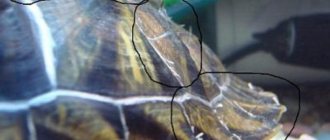Unless you know when a turtle was born, it is almost impossible to know its exact age.
Although you can count the rings on a turtle's belly, this method is usually better for determining when the turtle has eaten and when it has not. If your turtle is still small, you can compare it to the size of other turtles in its class to estimate its age. On a note! Determining age based on external characteristics (size, weight, number of growth lines) becomes increasingly inaccurate as a turtle ages and is highly unlikely in older animals. A turtle's appearance can say a lot about its life with its previous owners, but little about its age.
Height and growth rate of turtles
The growth of the turtles can be seen by the light seams between the carapace scutes. If the turtle grows quickly, the new horny layers along the periphery of the scutes become very light, then processes of pigment cells (dermal melanophores) grow there and pigment is transferred along them, usually in the form of thin rays or dark spots. When these growth rings “age”, the pigmented zones will not differ from the previous ones. This is the cost of accelerated growth in captivity. (c) D.B. Vasiliev.
As young turtles grow, their body shape and shell color change. The shell elongates and darkens. When the turtle grows and becomes sexually mature, if it is a male, then it may have a depression on the plastron, a thicker and longer tail, and long claws. Eye color and nose color may also change.
Parameters of red-eared turtles born and living in nature:
| Age | Newborn | 1 year | 2 year | 3 year | 4 year | 5 year |
| Length (males) | 2.5-3 cm | 5-7 cm | 7-9 cm | 8-12 cm | 10-14 cm | 13 cm |
| Length (females) | 2.5-3 cm | 5-7 cm | 7-9 cm | 9-15 cm | 13-18 cm | 17 cm |
Parameters of land turtles, turtles born and living in nature (using the example of Testudo hermanni):
| Age | Newborn | 1 year | 2 year | 3 year | 10 years |
| Length | 30-34 mm | 48-52 mm | 56-60 mm | 75-90 mm | 13-16 cm (males) 15-18 cm (females) |
| Weight | 10-12 g | 25-35 g | 48-65 g | 95-150 g |
At home, the growth of a turtle depends on the size of the aquarium/terrarium, frequency of feeding, diet, and the addition of calcium to the food.
At what age do they reproduce?
Male turtles living in captivity become mature at the age of 4 years, the reproductive age of female turtles is 6 years. At home, males mate with females in February and March. After this, the female comes to land to lay eggs. In the terrarium you need to create conditions for reproduction.
After 105-150 days, small turtles with a body length of 3 cm are born. The optimal temperature is +21°C.
In one clutch the female leaves from 6 to 10 eggs
What makes determining the age of a turtle so difficult?
Size and weight are only conditionally acceptable for determining the age of Greek land tortoises. Forms of secondary sexual characteristics are also not suitable for determining age, since they are related to growth, which in turn is related to nutrition and maintenance. In some cases, a four-year-old animal raised in an apartment may already be a sexually mature animal, on par with the size of an adult animal taken from the wild.
How to determine the age of turtles: by size and number of rings on the shell.
Turtles are capable of reproducing into old age and regenerating this state. The color and pattern of the shell and plastron can change throughout a turtle's youth and adulthood and go hand in hand with growth as it ages. Wild animals have to deal with extreme weather conditions, thorny bushes and sharp rocks, predators and fires, so their carapace ages faster than those of neat animals in captivity. However, there are some external functions that can at least be used to determine the life phases of a turtle
Puberty
Experts say that the sexual maturity of reptiles depends on its habitat. If the animal lives in the wild, then the female becomes capable of laying eggs at 10-15 years. Males mature much earlier - at 5-6 years they can fertilize their chosen one.
Some reptile breeders claim that their pets themselves began to express their readiness to reproduce at 4-5 years of age. In fact, this should not be allowed. This is simply due to the improper maintenance of the animal.
After all, judging by human standards, a reptile (female) at 4 years old is still in its early adolescence, comparable to a 10-12 year old girl. Like a child, a reptile can be fertilized and even lay eggs. Another question is how this will affect the health of the turtle itself and its offspring.
Therefore, experts categorically prohibit keeping young females under 10 years old together with males.
Since the average lifespan of a reptile is 30-40 years, after 25 years the Central Asian land turtle begins to grow old. But some females are still able to lay eggs.
But at this age, for a reptile to give birth to offspring is a very serious burden on the body. Therefore, this must be prevented. It is best to limit contact between older females and males who have reached their twenties.
In order for pets to live long in captivity, it is necessary to take into account all the nuances of their proper maintenance.
What are turtle growth rings
Turtles that grow in their natural environment regularly alternate between growth and pause phases each year. Therefore, every spring/summer a new growth ring is formed along the growth plates. (photo 1)
Thus, the better the turtle keeper is able to recreate the natural annual rhythm, the more uniformly the growth rings/stripes appear, and the easier it becomes to determine the age of the animal under human care.
Turtle growth rings (photo 1).
Turtle growth rings (photo 2).
Turtle growth rings (photo 3).
More difficult is determining the age based on the growth rings of turtles, which begin to hibernate in a warm terrarium, then hibernate outdoors or in an incubator, and in April wake up again in a heated house. There are several growth phases per year, as is the case with this 5-year-old Testudo Hermanni Boettgeri. (photo 2)
It is almost impossible to determine age based on rings on turtles that did not hibernate from their youth, during their period of greatest growth. In this case, their growth lines are irregular and barely outlined with each other, as is the case with the animal shown in the photo, which spent its youth in the living room without hibernating. (photo 3)
Variety of aquatic small turtles
If turtles grow no more than 12-13 cm in length, then they are considered small. There are several types of them:
- closing;
- spotted;
- flat;
- Chinese-three-keel.
Locking turtles
This species of small turtle includes several subspecies, such as the mud ruby, the common musk, the mud yellowthroat, and the musk keel. In the natural environment they can be found in South and North America, as well as in the USA. All turtles have a rounded carapace with a rib-like outgrowth of the neck plate. When in danger, the turtle closes the hole, which makes it more protected. Mud turtles are characterized by having webbed feet.
The diet of turtles is dominated by animal food, but they also happily eat plant foods. The yellow-throated turtle grows to a length of about 13 cm, and the red-cheeked turtle grows no more than 11 cm in length.
Flat turtles
Their height limit is 8-9 cm. Turtles have an elongated muzzle and a proportional head size. There are small protective shields on the neck. The carapace is oval and slightly elongated forward with a slight convexity. Each paw has 4-5 toes.
Flat turtles have several subspecies:
- Homopus boulengeri;
- Homopus areolatus;
- Homopus signatus;
- Homopus femoralis;
- Homopus solus.
They differ in the color of the carapace, which can be brown, olive or another shade. As a rule, females are slightly larger than males. The female can lay up to 4 eggs in one clutch.
Spotted turtles
This species of turtles belongs to the amphibians, since they feel good both in water and on land. It grows no more than 12 cm in length. For normal maintenance, turtles need to have a piece of land in the aquarium for rest.
Chinese three-keeled turtles
This type of turtle is recommended for beginners, as it is easy to care for and undemanding when it comes to food. They can grow up to 13 cm in length. To keep them, you will need an aquarium with a capacity of up to 100 liters.
What’s most interesting is that in some countries it is prohibited to keep these turtles at home.
The first years of a turtle's life
Already in the egg, the first growth ring is laid on the vertebral and rib plates of the shell. Growth rings are not yet visible on the plastron. (photo 4). The same animal a year later: (photo 5).
Turtle annual rings (photo 4).
Turtle annual rings (photo 5).
In the first year of life, a second ring is formed on the carapace and plastron. If the fry are kept warm, receive more food and their hibernation takes place in a shorter period than that of older animals, then already in the first year of life the animals can observe the formation of 2 - 3 growth rings. If turtles are in their natural habitat and often burrow into the ground in the fall, where they barely grow in their first winter, only one growth ring can be observed in such individuals in the first year of life.
Turtle annual rings (photo 6).
Turtle annual rings (photo 7).
Until about 12 years of age, you can get a fairly clear estimate of age by counting growth lines for turtles that have been in their natural habitat. (photo 6, 7).
At the age of 5 years, the structure of the growth lines, on the so-called baby plates, begins to disappear and is barely visible after 8 years of the turtle's life. In the harsh conditions of life in the wild, this is certainly likely to take longer than for turtles living in terrariums. Thus, the existing clear structure of the growth line of the children's plates indicates the young age of the turtle, even if the animal is already very large.
What difficulties may arise
Turtles are considered long-lived. These amphibians can live almost 120 years. And if all maintenance measures are followed when keeping them at home, then reptiles can outlive not only their owners, but also their children and even grandchildren.
In captivity, this amphibian animal can be kept in simple conditions; they do not require special care. But you definitely need to equip an aquarium with a large volume, about 150-200 liters. It must maintain a temperature of at least 25-30 degrees.
It is worth noting! Until a certain age, it is almost impossible to determine the sex and age of a land turtle. Full puberty begins at about 6-8 years of age, but visible signs may appear even later than this time.
Middle aged turtle
With age, the growing new growth rings shrink and are so close to each other that their boundaries can only be seen through a magnifying glass. The approximate age of such individuals is about 15 years. The animal has almost reached its final size. (photo 8).
Turtle annual rings (photo 8). Turtle annual rings (photo 9).
The growth rings on the carapace and plastron begin to gradually level out when the turtle is 30 years old. The horny plates become smoother. This process takes place over several decades. (photo 9).
Third way
Another evidence of the years the turtle has lived is the intensity of the color of the shell and the structure of its body. The younger the turtle, the lighter and brighter its color.
Only at four years old does the animal’s shell begin to darken. During this period, the age rings that appear on the shell are the same color as the previous ones, but the old ones become increasingly darker. Over time, they almost turn black, which is why older reptiles also become almost black.
In addition, in mature turtles, the shell acquires a regular oval shape over the years, loses its surface roughness, becoming almost smooth with grooves barely perceptible to the touch.
In conclusion, I would like to note that the age of any animal is indicated primarily by its behavior - young individuals of all types of earthly fauna are curious, active, and have a large supply of energy; mature age reminds itself of its poise, sometimes fatigue and a sedentary lifestyle. Turtles are no exception in this regard.
Old turtles 50+
Greek tortoises can live longer than humans. In the photo there are 2 females over 100 years old. (photo 10, 11).
Turtle annual rings (photo 10).
Turtle annual rings (photo 11).
The following external signs may indicate an old turtle:
- absolutely smooth plates without growth rings;
- worn claws;
- artificial irregularities (chips) of the shell and plastron.
In a natural habitat, the aging process of the bone plate and limbs naturally develops faster than in a protected environment in a terrarium.
- "monolithic shell";
- completely healed injuries;
- jagged plastron, more often in males than in females; changing the original color of the carapace to a lighter one;
- erasure and final disappearance of the black pattern on the carapace and plastron.
Turtle annual rings (photo 12).
Turtle annual rings (photo 13).
Turtle annual rings (photo 14).
How to determine the sex of a reptile
When the question arises of what gender, you should look at the tail, the shape of the shell, limbs, head and behavioral characteristics.
- Tail. In males it is thinner and longer, while in females it is short and thick. In addition, males periodically pull out the genital organ. The cloaca in females resembles an asterisk and is located closer to the base of the tail.
- Shell shape. In males it is elongated and narrow with a plastron concave inward. Females are rounder and wider with a flat plastron. It is noteworthy that the latter are usually larger than the former.
- Limbs. Males have elongated claws for courting a partner during the mating period.
- Head. Different species of turtles have sexual differences in the color and shape of their heads, as well as eye color.
- Behavior. Males usually flirt with females, showing their interest in them by chasing, biting on the neck, scratching with their claws.
How to count the rings on a turtle's shell
Select a shield to count. To determine age, you can count the number of rings on the turtle's shield. The scute is the shell that covers the turtle's shell. Keep in mind that the ring usually grows when the turtle is feeding and hungry, so this method should only be used as a rough estimate. In other words, turtles develop rings when they are very hungry or have enough food, not just in winter and summer.
Count the rings. The ring in the scutellum usually consists of a wider ring of one color and a narrow ring of another color, which alternately grow. Theoretically, the wider range represents a period of adequate nutrition, especially during the warmer months. In contrast, the narrower circle represents a period of food shortage, usually in winter. Therefore, by counting the number of rings and dividing by 2, you can approximately estimate the age of the turtle.
- Look for the ring. The scutum does not reflect the age of the turtle, so there is no need to count the scutum. To be precise, you need to find the ring inside the shield.
Estimate age. After counting the rings, guess the age of the turtle. For example, let's say a turtle has 14 rings and every 2 rings represent a year, you can assume the turtle is 7 years old.
- Both farmed and wild turtles have rings.
- After the turtle reaches 15 years of age, the ring will be longer and denser, and at this time it is difficult to determine age.
Count the rings on the turtle's shell.
Measure the turtle's shell.
How many years do land turtles live?
The lifespan of a turtle in nature and at home is different, and depends on the conditions of detention and species characteristics. As a rule, the lifespan of individuals in captivity is 2-3 times less than that of wild turtles, but the opposite situation also occurs.
Life expectancy of land turtles depending on the species and habitat:
| Type of turtle | Life expectancy (years) | |
| Captive | In natural conditions | |
| Mediterranean | 20 – 25 | 50 – 70 |
| Central Asian | 10 – 30 | 50 — 60 |
| Land leopard | 60 – 75 | 50 — 60 |
| Balkan | 50 | 75 — 100 |
| Indian (star-shaped) | 60 – 80 | 40 — 50 |
| Egyptian | 25 – 30 | 30 |
Creating comfortable living conditions will help extend the life of a turtle.
This is first of all:
- equipment for the place of residence, including a terrarium, a house, a feeding trough and a drinking bowl;
- a balanced diet including vitamins and mineral supplements;
- maintaining temperature in the range of +21-35°C;
- daily UV exposure;
- hygiene procedures, including bathing, trimming claws and beaks.
Measure the turtle's size
Measure the size of the turtle. A turtle's size can be used to determine its age, especially when it is very young. Measure it from start to finish and get a general idea of its size. Try to get the turtle to stand still so you can measure it with a ruler. Place tasty food in front of the turtle so that it can poke its head out of its shell.
Find the typical size of turtles of this species. Find out your turtle's species growth chart. Be sure to find your turtle type, even turtles of the same name have different sizes. You can search online or go to the library to find out what kind of turtle you have.
- For example, a southern tortoise usually does not exceed 15 cm, while a large western tortoise can grow up to 20 cm.
- Farmed turtles grow faster than wild turtles. Please note that increasing size may give a misleading idea of the turtle's age.
Compare the turtle with the size chart. Once you find the size chart, see how your turtle compares to the chart. If the turtle is not yet fully grown, you can estimate its age roughly.
On a note! A low quality shell can make a turtle appear older than it actually is. For example, if a turtle has been malnourished for several years, its shell may be rough and uneven, causing people to misunderstand its age. Therefore, when guessing the age, do not pay too much attention to the appearance of the turtle.
Boy or girl?
The sex of a reptile can be determined only after its shell reaches a length of 12-14 cm; at an early age it is impossible to distinguish between them. The best way to determine the sex of turtles is by comparing representatives of both sexes.
The male's claws will be longer and thicker. The ventral part of the shell, the plastron, is concave in males and flat in females. The eyes of females are brighter in color - this is their only decoration, and the only way to attract a partner.
The shape of the shell in boys is long and narrow, while in girls it is round and short.
The cloaca in males is in the form of a longitudinal line, and in females it is in the form of an asterisk. The tail of males is wide at the base and thick along its entire length. In females it is thin at the base and short.
The sex of reptiles is also determined by their behavior: males are more active, show more interest in females, flirt, nod their heads, bite the neck.
To correctly determine the sex and age for breeding turtles in captivity, it is better to seek advice from veterinarians who can more accurately answer these questions.
Lifespan of turtles
The loss of eggs due to nest predators is 40-95%. The survival rate of young animals is 10-55%; at the age of 10 to 15 years, 10-15% die per year. A complete change of generations occurs every 20 years, and animals aged 30 years are already rare. At home, turtles often die from infections and poor maintenance. But on average, small turtles live for 50 years, large ones for 80 years, and very large ones for 150-200 years.
Approximate data taken from observations of herpetologists in Zoos and private collections:
- Central Asian - 40-50 years; red-eared - 40-50 years;
- Indian roofing turtle (Kachuga tecta) - 37 years;
- box turtles - 50-100 years;
- Blanding's turtle (Emydoidea blandingii) - 60 years; desert gopher (Gopherus agassizii), sea turtles - 80 years;
- radiant - 85 years;
- Balkan (Testudo hermanni) - 90 years;
- spur-bearing - 115 years;
- Galapagos, Seychelles - 150-180 years.
The lifespan of a turtle depends greatly on its care. Some people have turtles that are 20-30 years old or even 40-50 years old, but many of them, due to poor maintenance, have many senile diseases and do not live long.
Conditions for keeping different types of turtles
Mud turtles spend almost their entire lives in water and are only rarely seen on land.
Therefore, an aquarium with a capacity of 50-70 liters is suitable for them. To ensure conditions are close to natural, soil is poured onto the bottom of the aquarium and aquatic plants are planted, although this is not necessary. The main thing is that there is an object at the bottom that serves as a shelter for the turtle. It can be driftwood or a clay pot, but heat-treated for greater stability. The water temperature is maintained at +22-25ºС. It is not recommended to keep males of different ages in the same aquarium. Locked turtles value their territory and can attack smaller, older turtles. Flathead turtles are characterized by difficulties in keeping at home. Therefore, for those who are not sure that they will be able to take care of them properly, one piece of advice can be given - it is better not to acquire or torture a small animal. If you follow all the recommendations and advice, these turtles can live in captivity for quite a long time.
Flathead turtles are not resistant to infectious diseases, so it is recommended to keep them separately from other turtles. In this way, you can extend their life and also stimulate them to reproduce. But for this to happen, they need to organize hibernation with certain temperature conditions, otherwise the males will not show their interest in the females. Turtles sleep for 2 months at a temperature of no more than +10ºС. Flat turtles feed on plant foods. They love warmth very much. The water temperature should be between +15-18ºС. There should be small pebbles at the bottom of the aquarium, a layer of no more than 2 cm.
Keeping spotted turtles is complicated by the fact that they prefer animal food, so you need to think carefully about whether they can be provided with aquatic insects, tadpoles, worms of various origins, small crustaceans, etc.
Chinese three-keeled turtles are quite voracious pets. Their diet includes a standard set of turtle products of both animal and plant origin. To make sure your turtle is consuming enough nutrients, vitamin supplements should be added to the diet. This type of turtle can withstand temperature differences from +12ºС to +30ºС. But this does not mean at all that their content should be approached from these data. It is better to experiment and not expose the animal to certain risks.
How to determine the sex of a small aquatic turtle, as well as obtain information about their contents, is possible by watching the corresponding video.
It is quite interesting to have small turtles at home. But interest alone cannot give you a lot of positive emotions. To get results, you need to invest something and that something is caring for small animals. In addition to the aquarium, you will also need light, warmth, and food.
Relationship between age and red spots
The most likely place to purchase a turtle for a home pond is a pet store, where the seller, among other data, must tell you the age of the reptile being purchased.
However, you, as the future owner, also need to navigate this issue, since reptiles of different ages feed differently and require different care, and having at least basic information about the future pet will be very useful.
So, the red-eared turtle is called due to the presence of red spots behind its eyes, which, in general, are in no way connected with the hearing organs.
Over the course of a turtle's life, as it grows, these spots change their color saturation from scarlet to burgundy.
The green carapace of the red-eared reptile with stains and stripes at a younger age becomes darker and duller as it ages.
An important indication of the age of a red-eared turtle can be the size of its carapace. But here it should be taken into account that in comfortable conditions a pet can grow at an accelerated pace, and there are many subspecies of red-eared reptiles, and not all of them have the same shell length/age ratio.
So how can you determine the age of your red-eared pet as reliably as possible?
The most accessible to a non-specialist for determining the age of red-eared reptiles are several methods - by the length of the carapace and the pattern on it, by its color and shape.
Reliable determination of a pet's age
It is not difficult for a specialist to determine its age just by looking at a reptile. But what should inexperienced owners do when they get such an unusual pet? You can use several methods - measure the length of the carapace, evaluate the nature of its pattern, the shape and color of the shield.
Method I
It's not 100% correct, but it's still worth a look because it's fairly easy to do.
Initially, it is important to find out whether the turtle is male or female, which is not so easy to do, especially if we are talking about a young individual. And only after this can you measure the diameter of the reptile’s shell and compare the data obtained with basic information:
- in the first year of life, the size of the carapace in red whales is 6 cm, regardless of gender;
- in the second year of life, the diameter of the armored shield of females increases to 9 cm, of males - to 8 cm;
- by the 3rd year, the carapace of females grows to 13-14 cm, and in males its length does not exceed 10 cm;
- in the 4th year, the size of the shell of males and females increases on average by 2 cm;
- in 5-year-old individuals, the length of the carapace is 18 cm in the case of a female, and 14 cm in males;
- at 6 years, the female’s shield increases by 2 cm, the male’s by 3 cm.
When a reptile reaches 6 years of age, its shell grows to its maximum size, and subsequently its diameter remains practically unchanged. Even if this happens, the increase is insignificant, and gradually the growth stops completely. The size of the carapace of a red-eared turtle is associated with the following factors:
- variety of diet;
- the size of the aquaterrarium;
- living conditions;
- the absence of hibernation or the presence of this period.
If you take into account such nuances, it is easy to understand that errors, often quite significant, cannot be avoided in calculations. Having obtained data in this way, you can correct the result using another technique - the most reliable.
II method
This method is based on determining the age of a reptile from the image on its carapace. Experts consider a turtle's shell to be its individual identifier, comparing it to a human fingerprint.
If the turtle eats well and lives in suitable conditions, then the shield pattern will be unique. But when a reptile lives in an unsuitable environment, is injured, becomes dry, or experiences other difficulties, its scutes can become deformed and peel off, which negatively affects the pattern.
There are a number of concentric rings on the shell that indicate its age. They appear in individuals after the first year of life, and then become intense during the 2nd and 3rd years. Every 6 months there are 2-3 more rings, after which the process slows down, and then only one ring appears per year.
If you count the number of rings, it is easy to find out how old the four-legged swimming pet is. Even if he came to a new home already as a large, adult individual. To get an accurate figure, you need to count the rings and take the average result. And in this case, some discrepancy with reality is possible.
III method
This method is based on assessing the color of the carapace - the intensity of the shade changes with age. The younger the individual, the lighter and calmer the color of its shell. After 4 years his tone becomes darker. Older red-eared turtles have an almost black shield, and this also applies to the rings.
As the reptile matures, the carapace becomes regular, oval in shape, and its surface becomes smooth, which is not the case in young animals. Young turtles are more active, energetic and inquisitive, they move more and climb everywhere. Old individuals are sedentary and phlegmatic; they can often be found resting. But such signs are observed not only in turtles, but also in other creatures - old age manifests itself in the same way in almost everyone.
It is worth noting that if the pet was purchased when it was still small, then there is no particular need to calculate its exact age. The main thing is to distinguish between the needs of young, adult and elderly reptiles and provide suitable food and amenities. But, regardless of age, the red ear needs clean water, ultraviolet rays, warmth and maintaining certain parameters of both water and air. This is the key to a healthy, long and fulfilling life for your pet.
Many animal lovers have problems when it comes to determining the gender of a pet, but if the differences in the structure of primary sexual characteristics in cats and dogs are more or less clear to all of us, then the task of finding out whether a red-eared slider is male or female can baffle anyone.
Fortunately, in reality everything is not as difficult as it seems.
Determination by shell color
During the process of growth and development, the color of the reptile changes along with its size. At a younger age, it has a more delicate and lighter color. At about four years of age, the shell begins to darken.
By this age, the rings have the same color, and when the shell begins to darken, the rings begin to darken along with it. In an “aged” turtle, both the shell and the rings are almost black.
As it grows and develops, the shell becomes more regularly rounded and smoother. The same cannot be said about a young turtle. The reptile’s honorable years can also be indicated by its way of life. Adults are calmer than young animals.
Basic information about redears
Representatives of the breed are aquatic reptiles, but they require an island of land. Such requests can be satisfied by purchasing a special tank - an aquaterrarium, and equipping it properly. In addition, such a container can be selected to match the design of the room, making it a real decoration of the room, and without compromising the comfort of its inhabitants.
When purchasing a cute little turtle, you should take into account that the pet will grow to a very impressive size. Life expectancy (from 30 to 50 years) is related to the living conditions of the reptile; the closer they are to natural ones, the longer the pet will live. The owner should know the age of the “red ear” not out of idle curiosity, but for two important reasons:
- to provide her with the most comfortable conditions;
- determine the appropriate diet and feeding regimen.
Calcium and vitamin supplements
Once a week, land turtles, including Central Asian ones, need to be given calcium and vitamin supplements in powder form (the best manufacturers are JBL and ZooMed). This must be done on an ongoing basis, since in captivity a turtle cannot obtain all the necessary elements from food alone
But, it is important to note that calcium will be absorbed only if there is a high-quality source of ultraviolet light. The fact is that in nature, land turtles do not get vitamin D3 from food, they can only produce it from the sun, and it is necessary for the absorption of calcium
Its only source for them is ultraviolet radiation. Therefore, it is useless to give vitamin D3 to land turtles as part of their supplements - it is not absorbed. Without D3, in turn, calcium cannot be absorbed.










